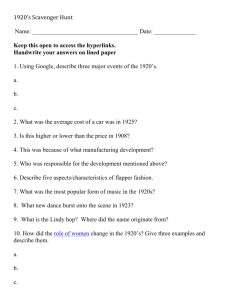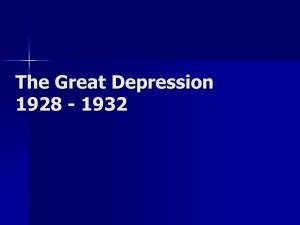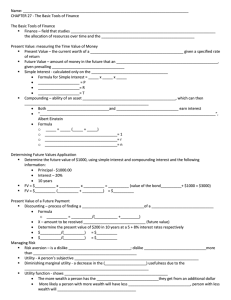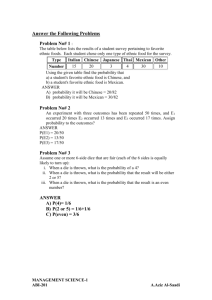A Brief History of the Dow Jones Utility Average
advertisement
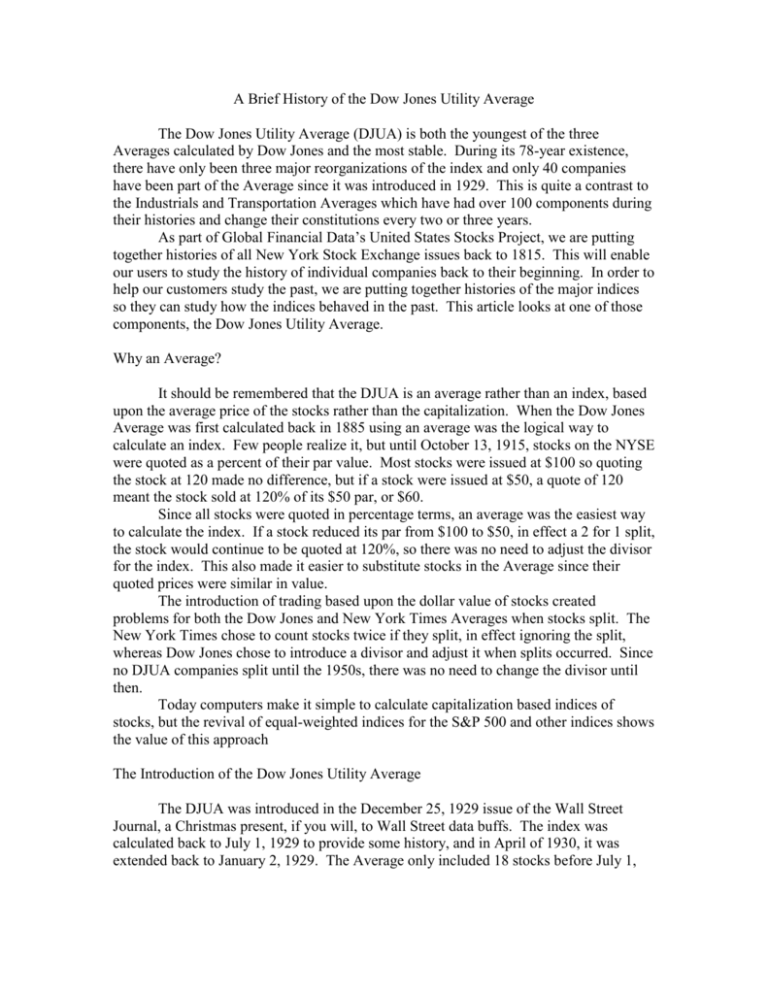
A Brief History of the Dow Jones Utility Average The Dow Jones Utility Average (DJUA) is both the youngest of the three Averages calculated by Dow Jones and the most stable. During its 78-year existence, there have only been three major reorganizations of the index and only 40 companies have been part of the Average since it was introduced in 1929. This is quite a contrast to the Industrials and Transportation Averages which have had over 100 components during their histories and change their constitutions every two or three years. As part of Global Financial Data’s United States Stocks Project, we are putting together histories of all New York Stock Exchange issues back to 1815. This will enable our users to study the history of individual companies back to their beginning. In order to help our customers study the past, we are putting together histories of the major indices so they can study how the indices behaved in the past. This article looks at one of those components, the Dow Jones Utility Average. Why an Average? It should be remembered that the DJUA is an average rather than an index, based upon the average price of the stocks rather than the capitalization. When the Dow Jones Average was first calculated back in 1885 using an average was the logical way to calculate an index. Few people realize it, but until October 13, 1915, stocks on the NYSE were quoted as a percent of their par value. Most stocks were issued at $100 so quoting the stock at 120 made no difference, but if a stock were issued at $50, a quote of 120 meant the stock sold at 120% of its $50 par, or $60. Since all stocks were quoted in percentage terms, an average was the easiest way to calculate the index. If a stock reduced its par from $100 to $50, in effect a 2 for 1 split, the stock would continue to be quoted at 120%, so there was no need to adjust the divisor for the index. This also made it easier to substitute stocks in the Average since their quoted prices were similar in value. The introduction of trading based upon the dollar value of stocks created problems for both the Dow Jones and New York Times Averages when stocks split. The New York Times chose to count stocks twice if they split, in effect ignoring the split, whereas Dow Jones chose to introduce a divisor and adjust it when splits occurred. Since no DJUA companies split until the 1950s, there was no need to change the divisor until then. Today computers make it simple to calculate capitalization based indices of stocks, but the revival of equal-weighted indices for the S&P 500 and other indices shows the value of this approach The Introduction of the Dow Jones Utility Average The DJUA was introduced in the December 25, 1929 issue of the Wall Street Journal, a Christmas present, if you will, to Wall Street data buffs. The index was calculated back to July 1, 1929 to provide some history, and in April of 1930, it was extended back to January 2, 1929. The Average only included 18 stocks before July 1, 1929 because quotes could not be found for two of the components, Commonwealth & Southern and Niagara Hudson Power (now Niagara Mohawk) before July 1929. The original index included 20 Utility companies broadly defined to include telephone companies, electric utilities and natural gas utilities. Of the original 20 companies, five remain in the Average today: Edison International (originally Southern California Edison Co.), PG&E (originally Pacific Gas & Electric), Public Service Enterprise Group Inc. (originally Public Service Co. of New Jersey), American Electric Power (originally American Gas & Electric Co.) and Consolidated Edison. Here is a list of the original components as introduced in December 1929. American & Foreign Power Electric Power & Light Co. American Gas & Electric Co. Engineers Public Electric American Power & Light Co. International Telephone & Telegraph American Telephone & Telegraph National Power & Light American Water Works & Electric Co. North American Co. Brooklyn Union Gas Pacific Gas & Electric Columbia Gas System Public Service Co. of N.J. Consolidated Gas System Standard Gas & Electric Co. Consolidated Edison Western Union Telegraph Niagara Hudson Power (later Niagara Mohawk Power) Southern California Edison (now Edison International) The DJUA remained unchanged until June 1, 1938 when the Average was reduced to 15 companies and the telephone companies were removed. One interesting consequence was that American Telephone & Telegraph was moved to the Dow Jones Industrial Average (DJIA) on March 14, 1939 and replaced IBM. IBM was not added back to the DJIA until June 29, 1979. During those 40 years, IBM was one of the best performing stocks on the New York Stock Exchange and if it had been kept in the DJIA during those 40 years, the Average would be much higher than it is today. The Public Utility Holding Company Act of 1935 The next major change in the DJUA resulted from the Public Utility Holding Company Act of 1935 (PUHCA). Until the 1930s, many utilities were owned by holding companies that stretched across state lines. The purpose of the legislation was to force Utility Holding Companies to divest themselves of utilities they owned across state lines in order that they could be regulated by individual states. The importance of the holding companies was reflected in the fact that up until the 1930s, S&P kept separate indices for Utility Operating Companies and Utility Holding Companies. Another reason for the law was Samuel Insull whose holding company owned a number of Chicago area public utilities as well as railroads. It was both the monopolistic influence his companies had and the repercussions caused by the collapse of his holding company that contributed to the passage of the PUHCA. The Energy Policy Act of 2005 repealed the PUHCA effective February 8, 2006. Since several members of the DJUA were holding companies. The problem not only was that the holding companies were shrinking in size and became completely different firms, but that the utility holding company stocks were quite volatile due to the uncertainty over the companies’ future. Six holding companies in the DJUA Average (Commonwealth & Southern Corp. Preferred, American Water Works & Electric, Electric Bond & Share, Electric Power & Light, Engineers Public Service and North American Co.) were removed. These companies either distributed shares in the new companies that were spun off to shareholders (Engineers Public Service Co.), they sold their interest in other utilities (North American sold its interest in St. Louis County Gas Co.) or they ceased operations as a domestic utility (Electric Bond & Share Co.) After the reorganization, the DJUA, it included four natural gas companies, three electric utility holding companies (which had direct control over their subsidiaries and did not have to reorganize under the PUHCA) and eight operating electric utilities. Despite the changes in the members of the DJUA, the divisor for the Average did not change. The divisor had been lowered from 20 to 15 when the Average removed 5 stocks in 1938, but no change in the divisor was made in 1946 despite changes in 40% of the Average. The Utility Average Modernizes No further changes were made in the DJUA for the next 38 years! It would be hard to conceive of the same components of the DJUA in 2007 still being their in 2045, but that’s the way things used to be. The change in 1986 only occurred because the Cleveland Illuminating Co. (a member of the DJUA) and Toledo Edison merged into Centerior Energy. So in one sense, it wasn’t really a change at all. In 1991, ARKLA, Inc. (later NorAm Energy) replaced Columbia Gas when Columbia Gas filed for protection under federal bankruptcy law, making it the first real change to the DJUA in 43 years. The third big change in the DJUA occurred in 1997 when the editors of the Wall Street Journal made an attempt to “revitalize” the DJUA by adding “some of the largest, most actively traded and innovative utilities in the country.” Given the fact that the country was in the middle of the Dot Com Boom, these changes were in keeping with the spirit of the times. The change also tried to make the index more geographically diversified, with less of an emphasis on east coast utilities, and to increase the number of natural gas companies represented in the index. Consequently, Columbia Gas, which had been replaced by ARKLA, Inc. was added back into the Average. The changes left the DJUA with ten electric companies and five natural gas companies. Three mergers in 2000 led to changes in the DJUA. Dominion Resources was added when it acquired Consolidated Natural Gas, and NiSource, Inc. was added when it acquired Columbia Energy. When PECO Energy acquired UniCom and reorganized as Exelon, the change necessitated the addition of a new company since both PECO Energy and UniCom had been in the DJUA. This led to the addition of AES Corp. Though located in Virginia, AES Corp. is a global company providing electricity and natural gas to customers on five continents giving the DJUA a global presence. One of the additions to the DJUA in 1997 was Enron, which certainly qualified as an innovative utility, but not to the benefit of its shareholders. It was removed from the DJUA on December 2, 2001 when it collapsed into bankruptcy. Enron was replaced by First Energy Corp. The DJUA in the 21st Century Will the DJUA remain as stable in the 21st Century as it did in the 20th Century? Probably not, but it will doubtless remain the most stable of the three averages Dow Jones Calculates. There were only three major changes in the Dow Jones Utility Average in the 20th Century, in 1938, 1946 and 1997. All of the other changes resulted from a merger/acquisition or bankruptcy. A complete list of the companies that have been in the DJUA since 1929 is provided below. The list includes both the date when the company was added, the date when it was removed and the symbol for the stock. In some ways the DJUA is a relic of the past, but in an era when the components of the S&P 500 change several times a month, having such a stable index is quite reassuring. Stock AES Corp American & Foreign Power American Electric Power American Power & Light Co. American Telephone & Telegraph American Water Works & Electric Co., Inc. Brooklyn Union Gas Centerior Energy Corp CenterPoint Energy Inc. Cleveland Electric Illuminating Co. Columbia Energy Columbia Energy Commonwealth & Southern Commonwealth & Southern pfd. Consolidated Edison Consolidated Natural Gas Co. Dominion Resources, Inc. DTE Energy Duke Energy Edison International Electric Bond and Share Co. Electric Power & Light Corp. Engineers Public Electric Enron Corp. Exelon First Energy Corp. International Telephone & Telegraph National Power & Light Niagara Mohawk Power NiSource, Inc. NorAm Energy North American Co. Pan Energy Corp. People's Energy Co. PG&E Public Service Enterprise Group Inc. Southern Co. Standard Gas & Electric Co. TXU Corp. Unicom Western Union Telegraph Co. Williams Cos. Added 10/23/2000 01/02/1929 01/02/1929 01/02/1929 01/02/1929 01/02/1929 01/02/1929 05/01/1986 05/08/1948 05/08/1948 01/02/1929 05/12/1997 07/01/1929 06/02/1938 01/02/1929 05/08/1948 01/31/2000 05/08/1948 05/12/1997 01/02/1929 06/02/1938 01/02/1929 01/02/1929 05/12/1997 05/08/1948 12/03/2001 01/02/1929 01/02/1929 07/01/1929 11/02/2000 08/05/1991 01/02/1929 05/08/1948 06/02/1938 01/02/1929 01/02/1929 05/12/1997 01/02/1929 05/12/1997 06/02/1938 01/02/1929 05/12/1997 Removed Current 06/01/1938 Current 06/01/1938 06/01/1938 05/07/1947 06/01/1938 05/11/1997 Current 04/30/1986 08/02/1991 11/01/2000 06/01/1938 05/07/1947 Current 01/30/2000 Current 05/11/1997 Current Current 05/07/1947 05/07/1947 05/07/1947 12/02/2001 Current Current 06/01/1938 06/01/1938 05/11/1997 Current 08/06/1997 05/07/1947 05/11/1997 05/11/1997 Current Current Current 06/01/1938 Current 10/22/2000 06/01/1938 Current Symbol AES AFW AEP AOW T AWW BU CX1 CNP CVX CG CG CW CW-PF ED CNG D DTE DUK EIX EBS EL EPU ENE EXC FE ITT NPL NMK NI NAE NA PEL PGL PCG PEG SI SG TXU UCM W WMB Notes American Electric Power was formerly American Gas & Electric Co. CenterPoint was formerly Houston Lighting & Power Co, Houston Industries and Reliant Energy Inc. Cleveland Electric Illuminating Co. merged with Toledo Edison into Centerior Energy Corp. on April 29, 1986 Columbia Energy was formerly Columbia Gas & Electric Corp. and Columbia Gas System, Inc, filed under federal bankruptcy law in August 1991 and merged into NiSource, Inc. on November 1, 2000 Consolidated Natural Gas Co. merged into Dominion Resources, Inc. on January 30, 2000 Dominion Resources, Inc. was formerly Virginia Electric & Power Co. DTE Energy was formerly Detroit Edison Co. Duke Energy was formerly Duke Power Co. Edison International was formerly Southern California Edison and SCE Inc. Enron Corp. filed for bankruptcy Exelon was formerly Philadelphia Electric Co. and Peco Energy Co. Niagara Mohawk Power was formerly Niagara Hudson Power NorAm Energy was formerly ARKLA, Inc. Pan Energy Corp. was formerly Panhandle Eastern Pipe Line Corp., then Panhandle Eastern Corp. and was acquired by Duke Energy Corp. on June 18, 1997 People's Energy Co. was formerly People's Gas Co. PG&E was formerly Pacific Gas & Electric Public Service Enterprise Group Inc. was formerly Public Service Electric & Gas Co. (NJ) TXU Corp. was formerly Texas Utilities UniCom was formerly Commonwealth Edison, and merged into Exelon on October 22, 2000 Sources “New Dow-Jones Utility Average,” The Wall Street Journal, December 25, 1929, p. 15 “The Dow-Jones Utility Average,” The Wall Street Journal, April 4, 1930, p. 16 “Change in the Utility Average,” The Wall Street Journal, May 20, 1938, p. 13 “Public Utility Stock Average of Dow-Jones Gets Major Revision,” The Wall Street Journal, May 8, 1947, p. 13 “Dow Jones Utility Average is Revised to Include Arkla,” The Wall Street Journal (Eastern Edition), August 2, 1991, p. C2 “Dow Jones Utility Average Will Change,” The Wall Street Journal (Eastern Edition), May 8, 1997, p. C.1 Public Utility Holding Company Act of 1935, Wikipedia

